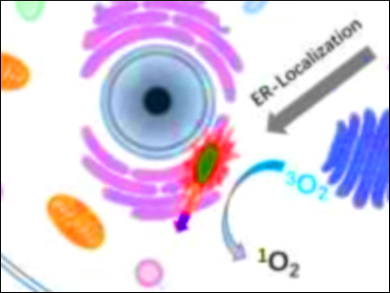Photodynamic therapy (PDT) uses a combination of light and photosensitizing drugs to kill cells, e.g., to treat cancer. Dual-targeted and activatable photosensitizers hold great potential for PDT because of their improved tumor selectivity and enhanced therapeutic efficacy.
Pui-Chi Lo, Ligang Yu, and colleagues, City University of Hong Kong, have developed a biotinylated and endoplasmic reticulum (ER)-targeted glutathione (GSH)-responsive zinc(II) phthalocyanine for targeted PDT. With a 2,4-dinitrobenzenesulfonyl (DNBS) moiety, the fluorescence emission and singlet oxygen generation of the phthalocyanine are quenched in its intact state (pictured below as “off”). Upon exposure to a high concentration of GSH, its photosensitizing properties can be restored in phosphate buffered saline and inside tumor cells (pictured below as “on”).

In addition, the compound shows a higher cellular uptake in biotin receptor-positive cancer cells and induces potent cytotoxicity upon irradiation. As this photosensitizer is localized preferentially in the ER, it could cause ER stress after light irradiation. The ER is an important organelle, responsible for, e.g., protein translocation, protein folding, and protein modifications. ER stress can, thus, trigger processes that can result in cell death.
- A Biotinylated and Endoplasmic Reticulum-Targeted Glutathione-Responsive Zinc(II) Phthalocyanine for Targeted Photodynamic Therapy,
Ligang Yu, Qiong Wang, Ka-Wing Yeung, Wing-Ping Fong, Pui-Chi Lo,
Chem. Asian J. 2018.
https://doi.org/10.1002/asia.201800852



